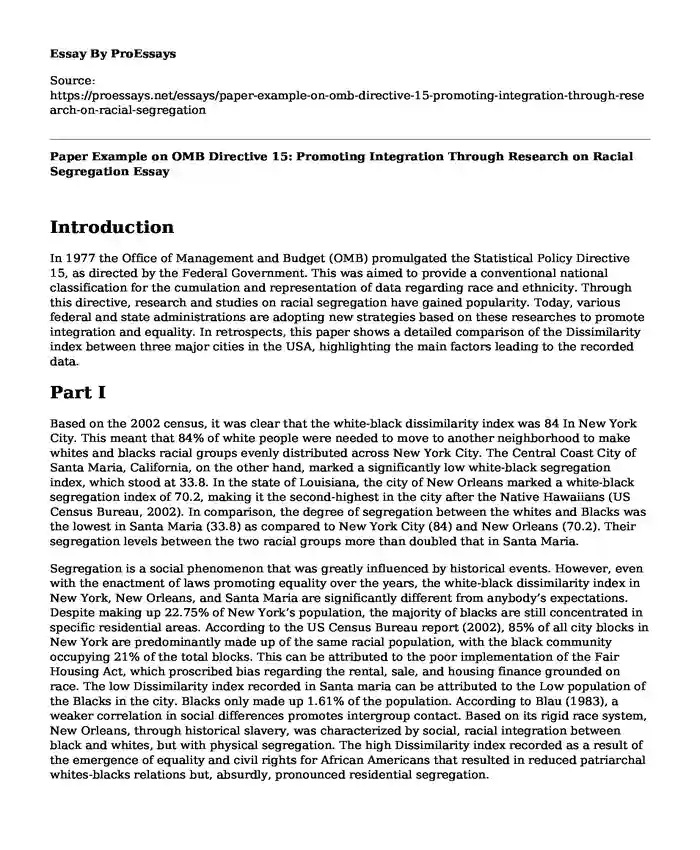Introduction
In 1977 the Office of Management and Budget (OMB) promulgated the Statistical Policy Directive 15, as directed by the Federal Government. This was aimed to provide a conventional national classification for the cumulation and representation of data regarding race and ethnicity. Through this directive, research and studies on racial segregation have gained popularity. Today, various federal and state administrations are adopting new strategies based on these researches to promote integration and equality. In retrospects, this paper shows a detailed comparison of the Dissimilarity index between three major cities in the USA, highlighting the main factors leading to the recorded data.
Part I
Based on the 2002 census, it was clear that the white-black dissimilarity index was 84 In New York City. This meant that 84% of white people were needed to move to another neighborhood to make whites and blacks racial groups evenly distributed across New York City. The Central Coast City of Santa Maria, California, on the other hand, marked a significantly low white-black segregation index, which stood at 33.8. In the state of Louisiana, the city of New Orleans marked a white-black segregation index of 70.2, making it the second-highest in the city after the Native Hawaiians (US Census Bureau, 2002). In comparison, the degree of segregation between the whites and Blacks was the lowest in Santa Maria (33.8) as compared to New York City (84) and New Orleans (70.2). Their segregation levels between the two racial groups more than doubled that in Santa Maria.
Segregation is a social phenomenon that was greatly influenced by historical events. However, even with the enactment of laws promoting equality over the years, the white-black dissimilarity index in New York, New Orleans, and Santa Maria are significantly different from anybody’s expectations. Despite making up 22.75% of New York’s population, the majority of blacks are still concentrated in specific residential areas. According to the US Census Bureau report (2002), 85% of all city blocks in New York are predominantly made up of the same racial population, with the black community occupying 21% of the total blocks. This can be attributed to the poor implementation of the Fair Housing Act, which proscribed bias regarding the rental, sale, and housing finance grounded on race. The low Dissimilarity index recorded in Santa maria can be attributed to the Low population of the Blacks in the city. Blacks only made up 1.61% of the population. According to Blau (1983), a weaker correlation in social differences promotes intergroup contact. Based on its rigid race system, New Orleans, through historical slavery, was characterized by social, racial integration between black and whites, but with physical segregation. The high Dissimilarity index recorded as a result of the emergence of equality and civil rights for African Americans that resulted in reduced patriarchal whites-blacks relations but, absurdly, pronounced residential segregation.
Part II
Despite not highlighting any racial groups, it is evident that the racial segregation index data in metropolitan areas from 1860 to 2000 most likely represents the black racial and ethnic group. The most notable characteristics of the data provided on the chart involve the difference in the growth rate of racial segregation over the years. For over 50 years from 1860 to 1910, the degree of dissimilarity gradually rose by 27%. This rate almost doubled to 51% in only 30 years and later dropped by 9% and 12% in 1970 and 2000 respectively (DeRango, 2001).
Among the main factors that contributed to the slow DI recorded in 1860 was the Supreme Court’s ruling of Dred Scott v. Sanford (1857) that stated that African Americans weren’t USA citizens. Free African Americans experienced segregation in the North and Upper North, where whites in the north banned them from public transportation and barred denied access to various public facilities.
The significant rise in DI values between 1910 and 1940 was mainly as a result of the great depression in 1930. Among the imposers of segregation is the support of economic institutions and the legitimization of the ideologies of white supremacy promoted by cultural institutions. The effects of the Great Depression were felt pretty much by each group in Americans. However, the African American community was hit the hardest. In approximation, more than half of black Americans were laid off by 1932 (Kollmann et al., 2018). In some Northern cities, whites called for black Americans to be sacked from any form of employment so long as there were unemployed whites.
References
Blau, P. M. (1983). Comments on the prospects for a nomothetic theory of social structure. https://psycnet.apa.org/record/1984-20268-001DeRango, K. (2001). Discrimination and Segregation in Housing. Employment Research Newsletter, 8(3), 1.
Kollmann, T., Marsiglio, S., & Suardi, S. (2018). Racial segregation in the United States since the great depression: a dynamic segregation approach. Journal of Housing Economics, 40, 95-116. https://www.sciencedirect.com/science/article/abs/pii/S1051137718300676
US Census Bureau. (2002). US summary: 2000 (Vol. 7, No. 6). US Census Bureau. https://books.google.co.ke/books?hl=en&lr=&id=D3k-R-SJ-DgC&oi=fnd&dq=US+Census+Bureau,+Census+2000+Summary&ots=t6grVKlHgt&sig=cPzTzoj8oa6W2J2rSW3zoQqKwX8&redir_esc=y
Cite this page
Paper Example on OMB Directive 15: Promoting Integration Through Research on Racial Segregation. (2023, Sep 17). Retrieved from https://proessays.net/essays/paper-example-on-omb-directive-15-promoting-integration-through-research-on-racial-segregation
If you are the original author of this essay and no longer wish to have it published on the ProEssays website, please click below to request its removal:
- Be Aware About Anti-Bias for Preschool
- Game Changer Identity: Toussaint's Last Words
- Minorities in Policing Essay Example
- Essay Sample on Women & Terror: The Unexpected Reality
- Essay Sample on Women's Suffrage: A Century-Long Battle to Win the Right to Vote
- Paper Example on Rousseau's Ideas Impact French Revolution: Declaration of Rights of Man
- Article Review Sample on Women, Addiction & Recovery: An In-Depth Analysis







